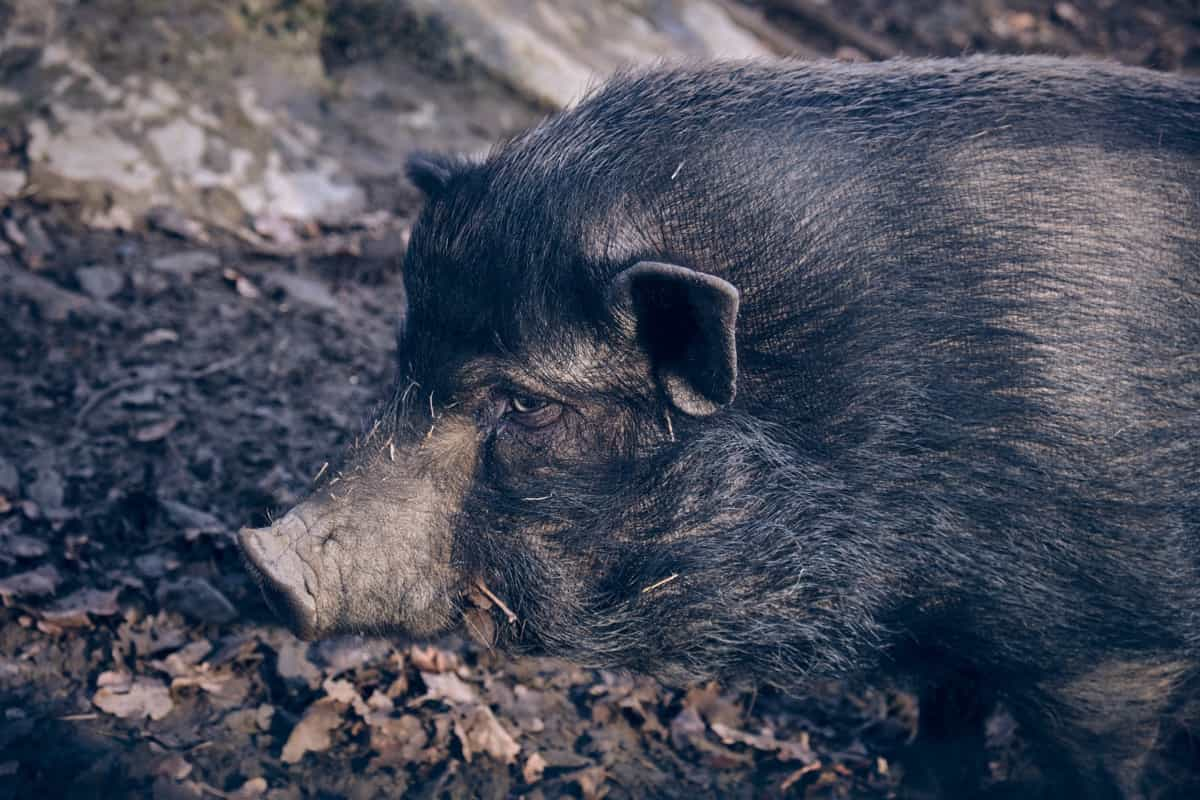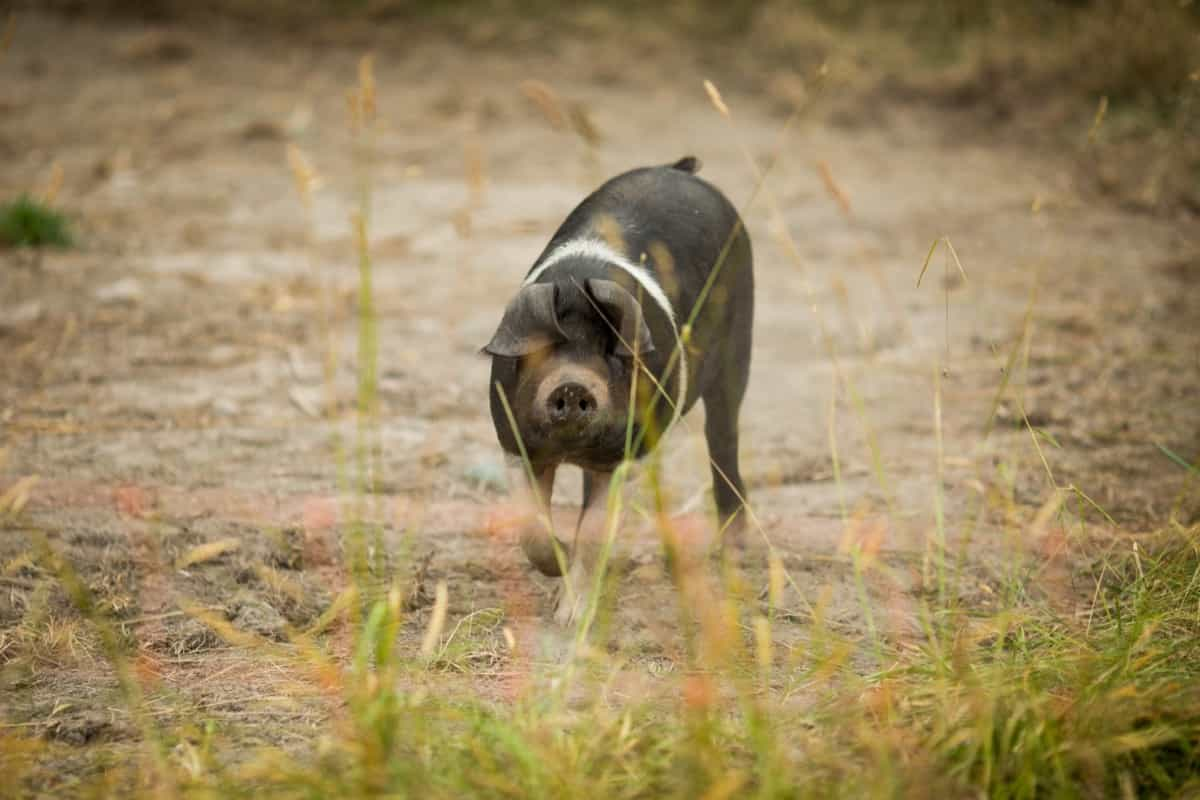Despite pigs’ reputation for fat meat, Hampshires are rare types that produce leaner meat. Maintaining this breed and producing lean meat is easy, making it a great choice for raising pigs. It makes sense that the Hampshire breed is most sought after for its meat, as its muscular physique makes for much leaner pork than other common breeds.

Additionally, you will not find a better carcass quality with almost any other breed of pig. Porks of this breed is also an excellent choice if you want to breed them for meat because they breed very easily and mature fairly quickly.
Hampshire Pig Facts
Origins of the Hampshire Breed
Hampshires originated in Northern England and Scotland in the 18th century, where they were initially unpopular due to their larger size. In the 19th century, however, breeders butchered these pigs before they reached full maturity, making them one of the most sought-after breeds. In the 1830s, a man named Mckay introduced Hampshire pigs to the United States, according to legend.
Hampshire pigs first flourished in Kentucky, where they were given the nickname “thin rinds” because of their thin skin. When breeding Hampshire pigs, a group of Kentucky breeders decided to keep as many purebred pigs as possible. It wasn’t until the 1960s that breeders from Ohio and other midwestern states began exporting the pigs to other countries. Currently, Hampshire pigs can be found worldwide in all climates and environments.
Hampshire Pig Physical Characteristics
- Hampshire pigs have medium-sized heads and small eyes that do not provide great vision. Domestic pigs don’t need good eyesight. Ensure the Hampshire pig has a wide forehead and a good distance between its eyes when determining its health and soundness.
- Most domestic pigs have floppy ears, but the Hampshire pig has upright, erect ears.
- Despite their lack of sharp teeth, Hampshire pigs have strong jaw and a solid bite. You should always be cautious when you are near the mouth of a pig. Consider clipping piglets’ teeth as well.
- Hampshire pigs have short tail that curls around and touches their lower backs. Its tail is long and level, resting high on its hindquarters.
- Like most other breeds of pigs, Hampshires have tusks regardless of gender. A pig’s tusk can grow to a different length depending on whether it is male or female. It is easy to tell a pig’s gender by measuring its tusks.
- Like all breeds, Hampshires have nails and hooves that need to be maintained regularly according to their terrain. Solid surfaces and grass combined in an enclosure will increase the time between trimmings.
- Hampshires typically have a long snout and an upturned nose that is small or medium-sized. Due to their poor eyesight, these pigs are extremely sensitive to smell. One white or cream-colored belt covers the upper chest and front legs of Hampshires, separating the all-black body from the rest of the body. As a result of their distinctive coloring, these pigs are still lovingly referred to as “the white belted hogs.”
- Since Hampshire pigs have muscular bodies, they are larger than most domestic pigs in the US, which produce such lean meat. Males can weigh up to 290 kg, while females can weigh up to 240 kg. Due to their size, pigs can be difficult to control, so many farmers choose to butcher them before they grow too large to ensure the meat stays lean.
- Hampshire sows can have up to two litters each year. Each time, between 7 and 15 piglets can be raised. Ensure your female pigs have 12 pronounceable teats with proper spacing between them.
- It takes seven months for a piglet to reach maturity. It is recommended that they are not bred until they are 12 months old.
In case you missed it: Chester White Pig Facts: Origin, Size, Physical Characteristics, Pros, and Cons

Advantages of Rearing Hampshire Pigs
- Hampshires exhibit a good carcass quality when used as meat animals and have well-muscled bodies.
- Hampshire pigs can become docile at times. In addition to being good-tempered, they can be kept as pets in the home.
- Raising them properly is not complicated, as Hampshire pigs are low-maintenance animals. Beginners and those without many land or climate control options will find them great.
- Breeding ability is one of the most important characteristics of Hampshire pigs. Sows of these breeds are praised for their ability to nurse their young for an extended period. A Hampshire female can give birth to up to 30 healthy piglets annually. It is well known that this breed produces healthy piglets, so you can be sure your yield will be high, thus increasing your pig population quickly.
- In contrast to what we initially thought about pigs, Hampshires prefer to keep their living areas clean. To avoid soiling their living space, they can assign a spot in the piggery for excrement.
Disadvantages of Rearing Hampshire Pigs
- Having your pig not properly fenced in can make it even more stressful. On their hunt for food, pigs can destroy the land, produce, and even man-made materials since they are natural foragers.
- They require enough space to roam, play, and live happily because of their size and temperament. Despite their size, they still need plenty of lands to stay enriched, even though they do not need acres of land like cows and horses. In addition, because of their ability to breed and their rapid growth rate, there is always the possibility of underestimating the amount of space they require.
- Finding Hampshire pigs when you first start breeding them can be difficult. You might have to pay a pretty high price if you can find them. In any case, if you successfully breed them, you will have entered an extremely lucrative and high-yielding market.
- An average Hampshire pig consumes 55 liters of water per day. With your business growing, this can be a lot of work and take a toll on your water bill.
In case you missed it: Yorkshire Pig Facts: Origin, Size, Physical Characteristics, Pros, and Cons

Conclusion
Hampshire pigs are an excellent breed for beginners, as discussed above. Their growth rate is rapid, their birth rate is high, and they are mostly self-sufficient. They produce lean meat, a great source of extra income. Your pigs must be happy and healthy, so you must have the time, energy, and supplies to do so.
- Ultimate Guide to Ossabaw Island Hog: Breeding, Raising, Diet, and Care
- Ultimate Guide to Juliana Pig: Raising Facts, Size, Diet, Care, and Lifespan
- Raising Lleyn Sheep: Disadvantages, Price, Uses, Characteristics, and Care
- Ultimate Guide to Meishan Pig: Breed Facts, Breeding, Raising, and Care
- Ultimate Guide to Teacup Pigs: Raising, Diet, Lifespan, Cost, and Care
- Guide to Raising Poll Dorset Sheep: Facts, Profile, Characteristics, Uses, and Care
- Ultimate Guide to Bighorn Sheep: Characteristics, Diet, Lifespan, Breeding, and Lifecycle
- Ultimate Guide to Raising Katahdin Sheep: Farming Facts, Breed Profile, Uses, and Care
- Ultimate Guide to Raising Oreo Cows: Belted Galloways Farming Facts, Profile, Uses, and Care